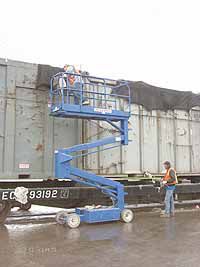| Workers tie down tarps and secure loads at the Utah County Transfer station so that loads ride correctly to their destination. |
They are huge buildings that sometimes accommodate hundreds of vehicles a day. For ECDC they are the beginning of a waste stream that is tracked and monitored from the time it is deposited at one of the facilities that dot the Wasatch Front to the time at which the materials will decay in the landfill, hundreds of years from now.
In the old days, people and disposal companies in the most populous place in Utah used to pull up to a dump site, often located on the western side of most of the Wasatch Front valleys, and just throw their trash directly into pits that were buried by bulldozers. Everything from household waste to the most toxic of substances were dumped there. But as the population grew, and the waste stream became ever more toxic, community officials began to realize that the space to get rid of refuse was quickly running out. In the 1960’s the environmental movement also began to point out that rather than landfills being places where trash could be dumped and forgotten about, they were becoming instead sources of deadly pollution to water supplies and soil. Federal regulations, then state laws started to push the operators to find new ways to dispose of materials.
In the 1970’s and 80’s landfills started to separate materials and began to recycle as well. Some of this was due to regulations, but some was also because of space. Dump sites had not only become so large that they were unmanageable but earlier practices had used up so much property they were running out of space to put the refuse in.
In the early 1990’s Utah County was the first to run out of space and began looking to ship their refuse other places. That is when ECDC stepped forward and began to ship that material to the site in Carbon County.
Later Weber County opened a transfer station and finally a couple of years ago, Salt Lake County also opened on the site of the old Vitro plant near 3300 South and 500 West.
| Trash is pushed into a pit where a container is awaiting as a backhoe compresses the material at the Weber County Facility. |
These transfer stations are the largest overall group of contributors to the waste stream that goes into the ECDC facility. Each facility is run a little differently from the others, with Utah County’s being the only place where refuse is taken. In Salt Lake the landfill in the Magna area is still very active, but the transfer station handles most of the municipal collection of MSW (municipal waste) in the county.
While it is hard for any entity to know what any one individual person throws in garbage can in their home, the waste stream at these facilities is carefully monitored before it is loaded in containers for shipment. Pits where the containers and cars are pulled up are watched by transfer station employees and monitored by state officials. The entities that operate these facilities must verify the overall contents of the containers before they leave the transfer station. A paper trail is started on each container so that in transport should an accident or fire happen, emergency personnel can get the information on what is in the car.
ECDC does not own the transfer stations, the sending entities do. The only thing ECDC does at the stations is some monitoring and supply the containers for the shipment. The railroad is responsible for the material during shipping.
Once it reaches the East Carbon facility, the company has the right to reject any load it does not deem proper to fit into it’s waste stream profile, which is deemed a Subtitle D class V non-hazardous landfill.

